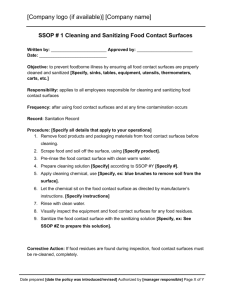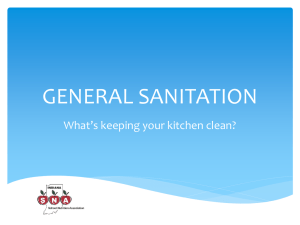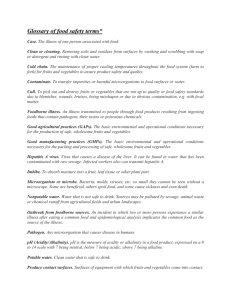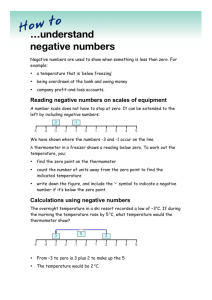Food Safety Presentation - University of Rochester
advertisement
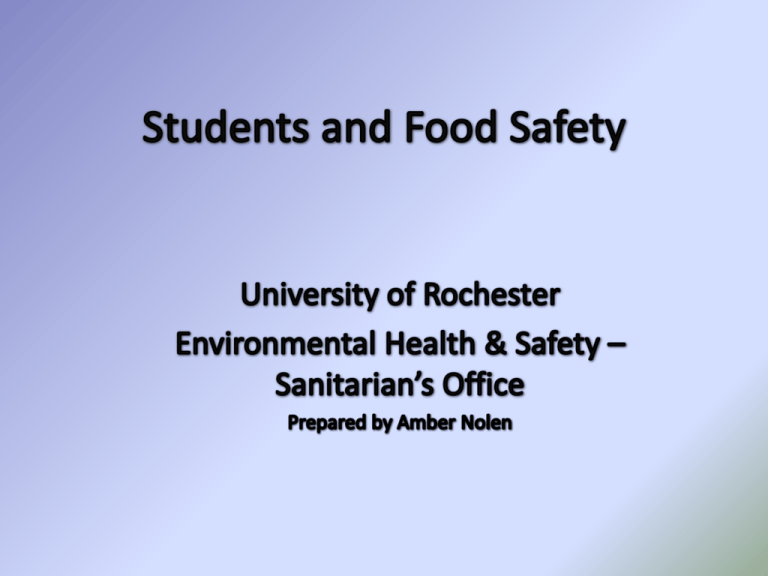
Roles of Students in Dining Services Roles Students have Dealing Directly with Safety and Food Safety • Serve Food • Prepare Drinks • Clean • Receive • Stock Importance of Knowledgeable Students • Maintain Safety Standards • Serve Safe Food • Keep Employees and Customers in a Safe Workable Environment Issues that can be Averted with Proper Training • Slips, Trips, and Falls • Cuts and Burns • Food borne Illness Outbreaks • Distribution of Unsafe Food Pertaining to temperatures, what is the danger zone? Why is it called that? “45 – 50°food spoils @ this temperature.” What is the proper way to lift heavy items? 3 out of 9 answered incorrectly “Carefully, don’t drop them.” “Don’t Know.” When the temp is above 42°Bacteria can grow” “Not entirely sure what the zone is, but food can spoil.” What does FIFO stand for? How would you apply this? 8 out of 9 answered correctly! “By the bottom so that they don’t drop/spill” “Use handle if available.” What temperature should a refrigerator never exceed? 4 out of 9 answered incorrectly or not at all Comparison of Prior and New PRIOR •126 Slides •45 Exam Questions •Created in 2002 •Contains Unused Information •Cost of Food Borne Illness •People at High Risk for Food Borne Illness •The Micro World – Bacteria, Parasites, Fungi, Viruses •Major Food Borne Illnesses •Different Types of Thermometers •Storage Guidelines for Raw Meat, Poultry, and Fish •Storage Guidelines for Dry Storage •Protecting Food During Preparation •Thawing Food •Food Preparation Practices •Cooking, Cooling, Reserving, and Reheating Food •Machine Ware washing •Integrated Pest Management NEW •21 Condensed Slides • 29 Exam Questions •Created in 2010 using ServSafe Essentials Fourth Edition. •Created for students employed by Dining Services at the University of Rochester . •Takes into consideration the roles students play. •Includes the proper training and knowledge needed for safety and food safety while maintaining University standards. •NEW Information •Burns •Slips, Trips, and Falls •Proper Lifting Techniques •Proper Methods for Using Knives Introduction of a NEW Food Service Safety Training Guide and Exam for Students Employed with Dining Services at the University of Rochester Factors Involved in Unsafe Food/Food Borne Illnesses Time-Temperature Abuse Occurs when food is held at unfavorable temperatures for extended periods of time. The Temperature Danger Zone for food ranges from 45°F to 140°F. Within this range food borne microorganisms grow. The recommended temperature for hot food is 140°F and higher while the recommended temperature for cold food is 45°F and lower. When receiving food make sure that it is received and stored quickly to avoid TimeTemperature Abuse. Factors Involved in Unsafe Food/Food Borne Illnesses Cross Contamination Cross Contamination is the passing of microorganisms from one surface or food to another. Contaminated surfaces, foods, and cloths that come into contact with cooked/ready to eat food or other food contact surfaces will cause Cross Contamination. An example of a contaminant would be raw chicken drippings , if this comes into contact with something else it is then contaminated. Factors Involved in Unsafe Food/Food Borne Illnesses Poor Personal Hygiene Employees with bad hygiene can contaminate food, food surfaces, and spread illness, along with offend customers. Employees should bathe daily, be clean shaven, have clean restrained hair(hat or hairnet), wear minimal jewelry and wear clean clothes. Instances when hand washing is needed: after using chemicals, after using the restroom, after mopping, sweeping, or handling garbage, after sneezing or coughing on hands, after touching cuts, sores, or boils, touching your hair or face, and after smoking, eating or drinking. Hands should be washed using the proper hand washing procedure whenever they are soiled and before starting work. When working with gloves your hands should be washed before and after changing gloves. Proper Hand Care and Hand Washing Procedure Proper Hand Care DO keep fingernails short and clean. Microorganisms can hide underneath nails. DON’T wear false nails they are hard to keep clean and can possibly fall off in food. DON’T wear nail polish, it can chip off into food and hide dirt under nails. DO cover cuts, burns, sores, infections and open wounds on hands with a bandage and glove or finger cot. Proper Hand Washing Procedure 1.Wet your hands with HOT(100°F minimum) water. 2.Apply soap. 3.Vigorously scrub hands and arms for at least 20 seconds. 4.Scrub between fingers and underneath fingernails. 5.Rinse hands thoroughly. 6.Dry hands and arms using a single use paper towel or hot air hand dryer. Do not use your apron to dry your hands. Make sure you change your gloves when switching tasks and also when they are soiled or torn. Don’t forget to wash your hands BEFORE and AFTER you change your gloves! DON’T eat or drink while preparing or serving food. Serving Food DO use clean sanitized utensils. When using hold them by their handle. Clean them once every 4 hours. Using tongs, deli sheets, and gloves are also safe ways to serve food. DON’T let your fingers touch the inside or rims of cups and glasses. DO wear gloves when handling fresh fruit that does not have a peel. DO hold dishes at their edges or by the bottom of them. DON’T let your bare hands come in contact with food. This is strictly prohibited. DO use a cover for your drink and store it below food surfaces or away from DO store utensils them. on a clean, sanitized food surface, in a well with running water, or in food with the handle extended above the edge of the container . DON’T store drinks or food near serving surfaces. Thermometers General Thermometer Guidelines Always clean thermometers after using and store them in their case. When temping different food products make sure you clean the thermometer with sanitizer or thermometer wipes first. Calibrate thermometer s on a regular basis using the Ice-Point Method. Insert the thermometer stem into the thickest part of the product. Wait until reading steadies to record correct temperatu re. NEVER use mercury or spirit filled glass thermomet ers to temp food. Ice-Point Method for Calibrating Thermometers 1. Fill a container with crushed ice and fill with clean water. 2. Insert the thermometer submerging the stem into the ice water making sure the tip does not touch the bottom or sides of the container. Wait 30 seconds or until the indicator steadies. You want the thermometer to read 32°F. 3. Use a wrench or the tool located on the case of the thermometer to calibrate if necessary. Hold the Hex Adjusting Nut securely with the wrench and rotate the head of the thermometer until it reads 32°F. Should I Go To Work? Stay Home If…… You have been diagnosed with a food borne illness. You have the following symptoms: Fever, Diarrhea, Jaundice, Vomiting, or a Sore Throat. Conditions Favoring the Growth of Food Borne Microorganisms FAT TOM Food Acidity Temperature Time Oxygen Moisture The Flow of Food Purchase Receive Store Prepare Cook Hold Cool Reheat HACCP- Hazard Analysis Critical Control Point Helps in identifying hazards within the flow of food. Serve Receiving Whenever a new shipment comes in remember to CHECK the products. Produce Cans Inspect for signs of spoilage. Check for mold, cuts, wilting and mushiness, insects, bad odor or taste, and also check to see if the color is off or if it has a dull appearance. Make sure that the product is not expired, it has a label, and that there are no dents, bulges, leaks, or rust. Dry Food Reject if packaging has holes, tears, punctures, dampness or water stains. An odd color or smell, spots of mold, or insects, eggs or droppings are also signs that you should not accept the product. Keep dry food dry because moisture aids in the reproduction of microorganisms. Use-by-Dates Check to make sure the product is not expired already or about to expire. Ready to Eat Food Check the packaging for holes or tears. Also check the temperature, if the product is above 45°F it is in the temperature danger zone, unless otherwise specified. Processed Frozen Food Check the temperature Ice Cream should be 6-10°F and other frozen foods should be around 0°. Reject these food items if not frozen or if packaging is torn. Signs of thawing and refreezing are liquid or fluid in the bottom of the case or there are water stains on the packaging, reject these items. Baked Goods Check the temperature if required by the manufacturer. Check for torn packaging, signs of pest damage and mold. Storing and Transporting Keep storage areas clean and dry. Clean and sanitize shelves and drawers. Store glasses, plates, and cups upside down and utensils with handles pointed up. Store food in proper areas designated for food and away from chemicals. Food must be stored 6” above the floor. Use FIFO for refrigerated, frozen, and dry storage areas. •FIFO means First IN First OUT •Rotate stock according to the expiration or useby-dates using the product that is to expire first. Store food in proper food grade containers. Make sure they are clean and sanitized. Cover the food to keep contaminants out and food fresh. Also cover food for transportation Label and Date All Products Clean carts, dollies, and trays often for sanitary food transportation. There is a Three-Day Shelf Life of food prepared by Dining Services at the University of Rochester. Potentially Hazardous Foods Milk and Milk Products(Including Soy Products) Fish, Shellfish, and Crustaceans Poultry , Beef, Pork, and Lamb Baked Potatoes/Potato Salad Allergies A food allergy is the body’s negative reaction to a certain food protein. Common foods that cause allergic reactions are: milk and dairy products, eggs and egg products, wheat, fish, shellfish, soy and soy products, and various types of nuts. It is important to pay attention to peoples needs when serving food. If a customer states that they have a severe allergy to milk use extreme measures and avoid milk at all costs. If making a Soy Latte for this customer use a clean and sanitized steamer pitcher used specifically for soy milk. Make sure there is no contact with the ingredient your customer is allergic to. Know what is in the products that you serve and if you are not sure ASK someone who knows! If still unsure assume that the product contains the allergen that your customer is asking about, you can never be too safe. Biological Hazards – Microorganisms such as bacteria, viruses, parasites, and fungi (examples of fungi: mold, yeast, and mushrooms), also certain plants and seafood carry harmful toxins or poison. Microorganisms are the most threatening and are responsible for the majority of food borne illness outbreaks. Food Borne Illness – Disease carried or transmitted to people by food. An outbreak occurs when 2 or more people experience the same illness after eating the same food. Contamination is the presence of harmful substances in food. There are 3 types of contaminants: Biological, Physical, and Chemical. Sanitation Physical Hazards– Foreign objects, hair, dirt, fingernails, metal shavings from cans, broken glass, and things natural to food such as bones. Chemical Hazards – Pesticides, food additives, preservatives, cleaning supplies, toxic metals used in cookware or equipment (examples are copper and pewter.) Use only food grade utensils and equipment to prevent chemical hazards. Store chemicals properly and away from food and food surfaces. If carbonated beverage systems are not installed correctly there is a risk for Chemical Contaminants. ALWAYS store chemicals away from food, utensils, and equipment. A separate area for chemicals should be designated. NEVER store chemicals in food grade containers. CHEMICALS NEVER mix chemicals together. Ensure that there is ALWAYS a CORRECT label on chemical bottles. CLEANING Removes food and other types of soil from surfaces. Cleaning Solution is kept in a GREEN Bucket and consists of SOAP and WATER CLEANING VS. SANITIZING For efficiency cleaning and sanitizing are a 4 STEP PROCESS 1. Clean the surface. 2. Rinse the surface. 3. Sanitize the surface 4. Allow to air dry. When to wash, rinse, and sanitize surfaces: Each time you use them – When you begin working with a different type of food – When you are distracted from your task at hand – At least every four hours SANITIZING Reduces the number of pathogens on a clean surface to safe levels. Sanitizing solution is kept in a RED bucket and consists of QUAT SANITIZER and WATER. Check with your location for standards on how to obtain sanitizing solution. Most locations have mechanisms that dispense the proper amount of solution for you. Cleaning and Sanitizing in a Three-Compartment Sink STEP ONE STEP TWO • Rinse, scrape, or soak items before washing. • Fill the first sink with a detergent soap solution at least 110°F. The water should be replaced when dirty or when the suds are gone. STEP THREE • Fill the second sink with hot water. Spray with water or rinse the items for cleaning here. STEP FOUR • Fill the third sink with a sanitizer solution. Using a test kit check the concentration of the sanitizer solution you are using. STEP FIVE • Place items upside down to drain. Allow items to air dry. Slips, Trips, and Falls Wear Non-Slip Shoes or Non-Slip shoe covers when working in kitchens or around slippery surfaces. NEVER leave boxes or large items in pathways or areas that are frequently traveled. Make sure the item is off to the side where it can be easily seen and avoided by passersby. Whenever there is a spill on the floor take action immediately! If you have a wet floor sign handy put it in place, if not have someone stand by the spill to inform people of the slippery floor while you go grab a wet floor sign. Get a mop and mop solution to clean up the spill. Leave the wet floor sign in place until the floor is dry. Make sure safety mats are in places where the floor can become slippery. For example: in front of sinks, fryers, or beverage areas. Keep your eyes on the path that your are walking and make sure you maintain a cautious pace, don’t run. Burns Be careful when working in Food Service Environments especially where HOT cooking equipment is used. Equipment to be cautious around includes Ovens, Grills, Kettles, Fryers, Waffle Irons, Panini Presses, Steam Wands, Hot Water Spouts, and more. First Degree Burns occur when only the outer layer of skin is burned. Skin will be red, swelling and painful. Treat these burns as Minor Burns. Second Degree Burns occur when the outer layer and the second layer of skin is burned. Skin will develop blisters, be intensely red in color and have a splotchy appearance. Severe pain will be felt along with swelling of the area. Medical Attention should be sought immediately. Treatment for Minor Burns Cool the Burn – Hold the burn under cool(not cold) water for 10 to 15 minutes or until pain goes away. Cover the burn with a sterile gauze wrapped loosely to avoid putting pressure on the burn. DO NOT USE ICE OR BUTTER TO COOL THE BURN. Use Painkillers – If the burn continues to hurt after being treated use over the counter painkillers such as Advil, Tylenol, or Ibuprofen to ease the pain. Tetanus - Burns are susceptible to tetanus. Tetanus shots are required every 10 years, if you have not had a Tetanus shot one may be recommended by your doctor. Proper Lifting Techniques 1. Plan ahead before lifting. Know your surrounding, what you are doing, and where you are going. Avoid Awkward movements when lifting something heavy. 2. Lift close to your body. This helps you to stabilize yourself and the object while lifting. Make sure you have a firm grip and keep your body balanced. 3. Keep your Feet shoulder width apart. This will help keep you stable. Take short steps to avoid falling. 4.Bend your knees and keep your back straight. 5. Lift with your legs. This will prevent you from injuring your back, because you legs are much stronger. Keeping your eyes focused and straight ahead. Proper Methods for Using Knives ALWAYS use a cut glove whenever cutting anything. The cut glove should be placed on the opposite hand that you would use a knife with. ALWAYS use slow, steady strokes when cutting; do not use a chopping motion. NEVER catch a falling knife! Chances are if you try to do this you will be cut. Let the knife fall to the ground while you move your body out of the way. NEVER leave a knife in water wells, sinks, or on countertops. Put them away in the knife safety storage area when not in use. Leaving knives out can cause people to be cut by them. When they are left in sinks they can be unseen by those not knowing they are in there. Pest Control Deny Pests Access •Check all deliveries to make sure pests are not being brought into the establishment. •Seal cracks in the floors and the walls, fill holes around pipes, and seal spaces around equipment so that pests cannot enter this way. •Keep areas uncluttered to prevent hiding spots for pests. Deny Pests Food, Water, and Shelter •Keep areas free of food debris and water especially when closing. •Dispose of trash quickly and correctly. •Ensure that food and food service supplies are stored properly. •Clean the establishment thoroughly including hard to reach spots using proper cleaning and sanitizing methods. Signs of a Cockroach Infestation •A strong oily odor will be present. •Look for droppings the size of pepper grinds. •Capsule shaped egg cases may be found. Signs of a Rodent Infestation •Evidence of gnawing can be found on food packaging, boxes, and more. •Look for droppings the size of raisins. •Tracks may be left on counters and in cabinets. •Look for nesting materials and holes created by these creatures. What to do if you have a Pest Infestation: •Alert Management as soon as possible •To prevent drain roaches sanitizer solutions can be poured down all drains •Traps can be used to catch rodents. Box Traps, Glue Boards, and Spring Bait Traps can be used. •Repellents and sprays can also be used. When using these in Food Service Establishments it is best that all equipment is covered and food is not present. Lead by Example and Teach Others Proper Personal Protective Equipment: Non-Slip Shoes, Gloves, Cut Gloves, Oven Mitts, Etc. Safe Practices Food Safety Posters used as Reminders Proper Equipment: Calibrated Thermometers, Sharp Knives, Step Ladders, Wet Floor Signs Etc.
